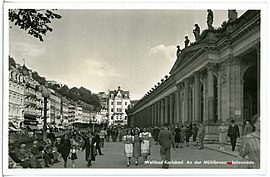
The Sudetenland is the historical German name for the northern, southern, and western areas of former Czechoslovakia which were inhabited primarily by Sudeten Germans. These German speakers had predominated in the border districts of Bohemia, Moravia, and Czech Silesia since the Middle Ages. Since the 9th century the Sudetenland had been an integral part of the Czech state both geographically and politically.
Fall Grün was a pre-World War II plan for the invasion of Czechoslovakia by Nazi Germany. Although some preliminary steps were taken to destabilise Czechoslovakia, the plan was never fully realised since Nazi Germany achieved its objective by diplomatic means at the Munich Conference in September 1938, followed by the unopposed military occupation of Bohemia and Moravia and the creation of a nominally independent Slovakia, in March 1939.

Konrad Ernst Eduard Henlein was a Sudeten German politician in Czechoslovakia before World War II. After Germany invaded Czechoslovakia he became the Gauleiter and Reichsstatthalter of Reichsgau Sudetenland under the occupation of Nazi Germany.

Hans Krebs was an ethnic German born in Moravia who was an ardent German nationalist who emigrated to Nazi Germany. He joined the Nazi Party, was elected to the Reichstag and was appointed a Regierungspräsident in the Sudetenland. He was also a member of the SS, rising to the rank of SS-Brigadeführer. In 1947, Krebs was executed in Prague for high treason by the Czechoslovak Republic.

The Sudeten German Party was created by Konrad Henlein under the name Sudetendeutsche Heimatfront on 1 October 1933, some months after the First Czechoslovak Republic had outlawed the German National Socialist Workers' Party. In April 1935, the party was renamed Sudetendeutsche Partei following a mandatory demand of the Czechoslovak government. The name was officially changed to Sudeten German and Carpathian German Party in November 1935.

A Reichsgau was an administrative subdivision created in a number of areas annexed by Nazi Germany between 1938 and 1945.

Karl Hermann Frank was a Sudeten German Nazi official in the Protectorate of Bohemia and Moravia prior to and during World War II. Attaining the rank of Obergruppenführer, he was in command of the Nazi police apparatus in the protectorate, including the Gestapo, the SD, and the Kripo. After the war, he was tried, convicted and executed by hanging for his role in organizing the massacres of the people of the Czech villages of Lidice and Ležáky.

German Bohemians, later known as Sudeten Germans, were ethnic Germans living in the Czech lands of the Bohemian Crown, which later became an integral part of Czechoslovakia. Before 1945, over three million German Bohemians constituted about 23% of the population of the whole country and about 29.5% of the population of Bohemia and Moravia. Ethnic Germans migrated into the Kingdom of Bohemia, an electoral territory of the Holy Roman Empire, from the 11th century, mostly in the border regions of what was later called the "Sudetenland", which was named after the Sudeten Mountains.

The Gaue were the main administrative divisions of Nazi Germany from 1934 to 1945.

The Gauliga Sudetenland, was the highest football league in the Sudetenland, the predominantly German-speaking parts of Czechoslovakia that were awarded to the German Reich on 30 September 1938 through the Munich Agreement. Shortly after the completion of the occupation on 10 October 1938, the Nazis reorganised the administration in the region, forming the Reichsgau Sudetenland.

The Reichsgau Styria was an administrative division of Nazi Germany consisting of areas in Styria, Lower Styria and southern parts of Burgenland. It existed from 1938 to 1945.

The Reichsgau Carinthia was an administrative division of Nazi Germany in Carinthia and East Tyrol and Upper Carniola in Slovenia. It existed from 1938 to 1945.

The Reichsgau Upper Danube was an administrative division of Nazi Germany, created after the Anschluss in 1938 and dissolved in 1945. It consisted of what is today Upper Austria, parts of Southern Bohemia, and a small part of the Salzkammergut which was annexed from Styria.

The Reichsgau Vienna was an administrative division of Nazi Germany based in Vienna, Austria. It existed between 1938 and 1945. Parts of Lower Austria were annexed to establish Greater Vienna, which then became the biggest city of Nazi Germany by area.

The Reichsgau Lower Danube was an administrative division of Nazi Germany consisting of areas in Lower Austria, Burgenland, southeastern parts of Bohemia, southern parts of Moravia, later expanded with Devín and Petržalka. It existed between 1938 and 1945.

The Reichsgau Tyrol-Vorarlberg was an administrative division of Nazi Germany consisting of Vorarlberg and North Tyrol. It existed from 1938 to 1945. It did not include East Tyrol (Lienz), which was instead part of Reichsgau Carinthia.

The Reichsgau Salzburg was an administrative division of Nazi Germany in Salzburg, Austria. It existed between 1938 and 1945.

Chief of Civil Administration was an office introduced in Nazi Germany, operational during World War II. Its task was to administer civil issues according to occupation law, with the primary purpose being the support of the military command in the operational areas of the German Army. CdZ would pass his authority to a corresponding civil government after the territory in question became in the rear of the operating armed forces.

The Holocaust in the Sudetenland resulted in the flight, dispossession, deportation and ultimately death of many of the 24,505 Jews living in the Reichsgau Sudetenland, an administrative region of Nazi Germany established from former Czechoslovak territory annexed after the October 1938 Munich Agreement. Due to harassment and violence, including during Kristallnacht, ninety percent of the Jews had already left the Sudetenland by mid-1939. The remaining Jews were subject to property confiscation and eventually deportation. During the later years of the war, tens of thousands of Jews and non-Jews were forced laborers in a network of concentration camps in the Sudetenland.















